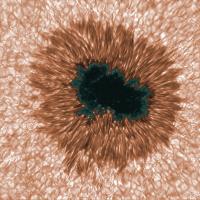Printable Version of Topic
Click here to view this topic in its original format
Unmanned Spaceflight.com _ Sun _ Ultrasharp Images Of A Sunspot
Posted by: SigurRosFan Oct 6 2005, 08:15 AM
New optics produce ultrasharp images of sunspot
News article: http://spaceflightnow.com/news/n0510/05sunspots/
More images: http://www.nso.edu/press/DALSA/
NOAA 0805:
Posted by: Tesheiner Oct 6 2005, 09:03 AM
Sunspot, that's you? ![]()
![]()
Posted by: SigurRosFan Oct 6 2005, 09:43 AM
![]()
![]()
Posted by: Myran Oct 6 2005, 01:17 PM
*Pust on the doc coat* Hmmmm, dunno what it is, but I think some penicillin could cure it! ![]()
Really amazingly sharp image though.
Posted by: SigurRosFan Oct 7 2005, 07:02 AM
Abyss! Abyss! ![]()
Posted by: chris Oct 7 2005, 09:31 AM
We won't have to worry about power either...
Posted by: ljk4-1 Feb 7 2006, 07:03 PM
Astrophysics, abstract
astro-ph/0602129
From: Juan Manuel Borrero [view email]
Date: Mon, 6 Feb 2006 17:20:10 GMT (28kb)
The uncombed penumbra
Authors: J.M. Borrero, M. Rempel, S.K. Solanki
Comments: 6 pages, 2 figures. to appear in the proceedings of the Solar Polarization Workshop IV
The uncombed penumbral model explains the structure of the sunspot penumbra in terms of thick magnetic fibrils embedded in a magnetic surrounding atmosphere. This model has been successfully applied to explain the polarization signals emerging from the sunspot penumbra. Thick penumbral fibrils face some physical problems, however. In this contribution we will offer possible solutions to these shortcomings.
http://arxiv.org/abs/astro-ph/0602129
Posted by: ljk4-1 Feb 9 2006, 03:33 PM
Astrophysics, abstract
astro-ph/0602176
From: Huw Morgan [view email]
Date: Wed, 8 Feb 2006 01:26:00 GMT (54kb)
The Impact of Sunspots on the Interpretation of Coronal Observations of the O VI Doublet
Authors: H. Morgan, Shadia Rifai Habbal
Comments: 4 pages, 3 figures
Journal-ref: ApJ Letters, 630, 2005, L189
Due to their high intensity of emission in the O VI 1031.9 and 1037.6A lines, even small sunspots on the solar disk can strongly influence the intensity of the radiative scattering component of O VI lines in the corona. Observations of O VI disk spectra show a 1032/1038 line intensity ratio of >2.6 in a sunspot compared to quiet disk values of 2. The enhancement of the 1032 line in comparison to the 1038 is likely due to interaction between molecular hydrogen emission from the sunspot and the chromospheric O5+. Modeling shows that a contribution from sunspots increases the coronal O VI 1032/1038 intensity ratio to values considerably higher than those achieved with a quiet disk or coronal hole spectrum. Therefore a re-examination of flow velocities derived from UVCS/SOHO streamer observations must be made. This modeling demonstrates that the inclusion of sunspots, when present, may lead to non-zero outflow velocities at lower heights in streamer cores in contrast to some existing model results.
http://arxiv.org/abs/astro-ph/0602176
Posted by: Pando Feb 10 2006, 01:24 AM
Haaaha! We'll have to go there at night so we won't burn up...
Posted by: ljk4-1 Feb 14 2006, 06:10 PM
Astrophysics, abstract
astro-ph/0602260
From: Alexander Kosovichev [view email]
Date: Sat, 11 Feb 2006 23:54:21 GMT (512kb)
Surface Magnetism Effects in Time-Distance Helioseismology
Authors: Junwei Zhao, Alexander G. Kosovichev
Comments: 19 pages, 8 figures, Astrophys.J., in press
Recent observations of helioseismic holography revealed that magnetic fields inclined to the line-of-sight direction could cause systematic variations in measured acoustic phase shifts, and that the surface magnetic field may shift the phases and impair the coherence of acoustic waves (known as "showerglass effect"). We examine how these affect time-distance helioseismology measurements. It is confirmed that the inclined magnetic field could cause variations in acoustic travel times inside sunspot penumbra, however, inversions of the measured times show that this effect only slightly shifts the location of negative sound-speed variations near the solar surface, but does not change the inverted deeper interior structures. Regarding to the showerglass effect, we find that outgoing and incoming travel time perturbations through sunspots are significantly smaller than those reported from helioseismic holography. In addition, our second-skip cross-correlation experiments demonstrate that inside sunspots, the half of the double-skip travel times are very similar to the mean single-skip travel times. We conclude that these surface magnetism effects do not cause considerable systematic errors in time-distance helioseismology of active regions.
http://arxiv.org/abs/astro-ph/0602260
Posted by: Ant103 Feb 14 2006, 10:46 PM
And say that this sunspot is big as the Earth. It's very amazing! Woow!!
Posted by: ljk4-1 Feb 15 2006, 08:26 PM
400-YEAR OLD SUNSPOTS: Today is the 442nd birthday of Galileo Galilei,
a figure of importance in the history of space weather. Contrary to popular
belief, Galileo didn't discover sunspots, but he was one of the first to observe
them using a telescope and he discovered many of their basic properties.
Visit http://spaceweather.com to learn more about Galileo's pioneering work
and to see actual drawings of sunspots he made more than four centuries ago.
Posted by: ljk4-1 Jun 5 2006, 04:04 PM
Long-term variation in distribution of sunspot groups
http://arxiv.org/abs/astro-ph/0606053
Powered by Invision Power Board (http://www.invisionboard.com)
© Invision Power Services (http://www.invisionpower.com)

